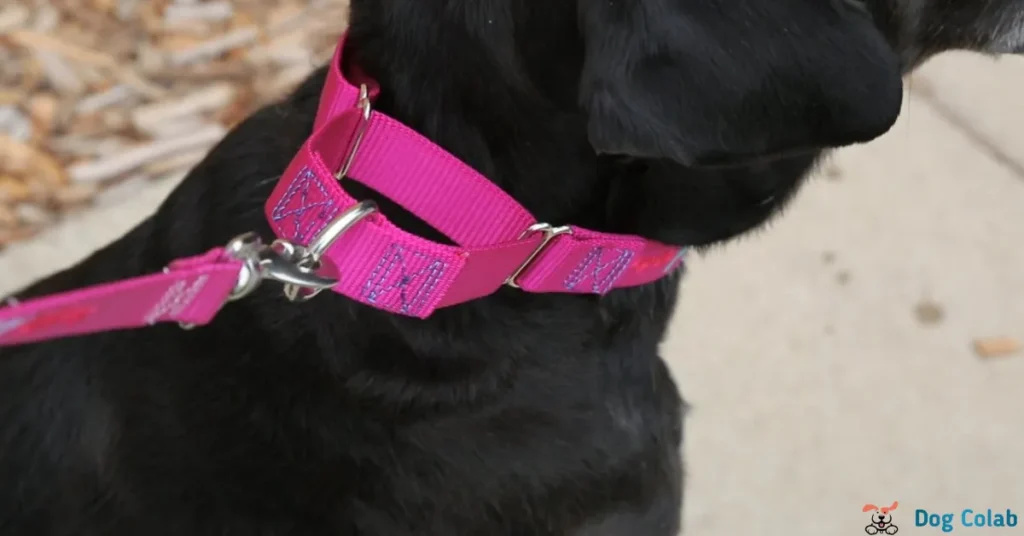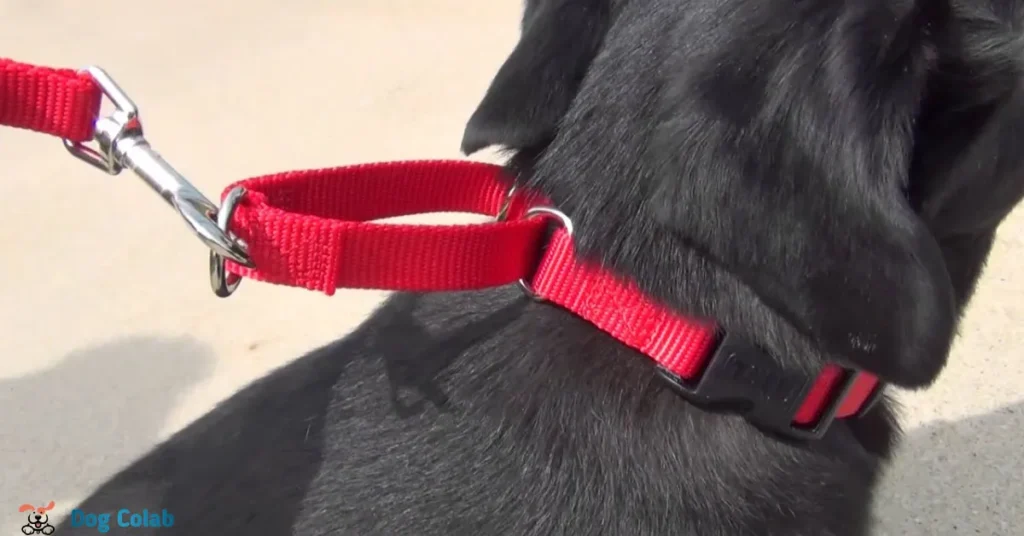Walking our furry companions is an essential part of their daily routine, providing both exercise and mental stimulation. However, for many dog owners, the experience can be frustrating when their dogs constantly pull on the leash. To address this issue, various training tools are available, and one popular option is the Martingale collar.
But, one question arises in some dog owners’ minds are martingale collars good for dogs that pull? So, In this blog post, we will discuss the advantages and disadvantages of using Martingale collars for dogs that pull and provide some tips for using Martingale collars properly.
What Is a Martingale Dog Collar?
A Martingale dog collar, also known as a limited-slip or no-slip collar, is a type of dog collar specifically designed to provide more control over dogs that tend to slip out of traditional flat collars.

The design of a Martingale collar includes two loops: a larger loop that goes around the dog’s neck and a smaller loop made of material like nylon or chain that attaches to the leash. When the dog pulls on the leash, the smaller loop tightens, gently and evenly distributing pressure around the dog’s neck without choking or causing harm.
The key feature of a Martingale collar is that it has a limited tightening function. When properly fitted, it can tighten to a certain extent but not fully close, avoiding excessive pressure on the dog’s throat and preventing potential injuries or choking. This controlled tightening action helps prevent the dog from slipping out of the collar, making it safer and more effective for dogs that are prone to escape attempts.
Are Martingale Collars Good For Dogs That Pull?
Martingale collars can be effective for dogs that pull, but their primary purpose is to prevent dogs from slipping out of their collars, especially for breeds with narrower heads and necks.

While they do provide some control over pulling behavior, they might not be as effective as other types of collars or harnesses designed specifically for leash training and managing pulling dogs.
If your main concern are martingale collars good for dogs that pull or address pulling behavior, there are other training tools that may be more suitable, such as front-clip harnesses or head halters. These options provide better control over the dog’s movements and discourage pulling by redirecting their attention or gently guiding their body.
Front-clip harnesses work by attaching the leash to the front of the dog’s chest, which helps to turn the dog’s body sideways when they pull, making it more difficult for them to continue pulling forward. This design encourages the dog to stay by your side instead of pulling ahead.
Head halters, on the other hand, fit over the dog’s snout and function similarly to a horse’s halter. When the dog pulls, the halter gently redirects its head, which in turn redirects its body and helps to control its movement.
Which Dog Breeds Should Use a Martingale Collar?
Martingale collars are particularly beneficial for dog breeds that have a head and neck structure that allows them to slip out of traditional flat collars easily. These breeds typically have a head size that is narrower than their neck, making it easier for them to escape from regular collars when they pull or back away.

Some dog breeds that are commonly recommended to use Martingale collars include.
- Greyhounds
- Whippets
- Italian Greyhounds
- Salukis
- Borzois
- Afghan Hounds
- Basenjis
- Pharaoh Hounds
- Ibizan Hounds
- Beagles (due to their strong scent drive, which can lead to pulling)
These breeds are referred to as “sighthounds” and often have a unique body shape with deep chests and slender necks, which can make it challenging for regular collars to stay properly in place.
It’s important to note that while Martingale collars are recommended for these breeds, individual dogs may have different leash-walking behaviors and preferences. Some dogs may respond better to other types of collars or harnesses, so it’s essential to consider your dog’s specific needs, training requirements, and comfort when selecting the most appropriate collar for them.
If you’re unsure about which collar to choose, consulting with a professional dog trainer or a veterinarian can help you make the best decision for your furry companion.
Pros And Cons of Martingale Collars
Martingale collars have both advantages and disadvantages. Understanding these pros and cons can help you decide are martingale collars good for dogs that pull.
Pros

- Escape Prevention: Martingale collars are specifically designed to prevent dogs from slipping out of their collars, making them ideal for breeds with narrower heads and necks.
- Gentle Control: When fitted properly, Martingale collars provide gentle and even pressure around the dog’s neck, avoiding choking or discomfort while still offering more control compared to regular collars.
- Training Aid: Martingale collars can be helpful in training dogs to walk on a leash without pulling. The limited tightening action discourages pulling behavior without causing harm.
- Wider Use: Martingale collars can be used for various breeds and not just sighthounds. They can also be suitable for dogs that have a tendency to back out of collars or for dogs that are in-between sizes.
- Durability: Many Martingale collars are made from sturdy materials like nylon or chain, providing durability and longevity.
Cons

- Fit and Adjustment: Proper fitting is crucial with Martingale collars. If not adjusted correctly, they might be ineffective or cause discomfort for the dog.
- Supervision: Martingale collars should not be left on unsupervised dogs to avoid any potential accidents or entanglement.
- Limited Control: While effective in preventing escapes and discouraging pulling, Martingale collars may not provide the same level of control as other training tools, such as front-clip harnesses or head halters, for managing strong pullers.
- Restricted Use for Training: Although they can be helpful in leash training, Martingale collars are not intended as a long-term substitute for proper training and may not address underlying behavioral issues.
- Not Suitable for All Dogs: While Martingale collars work well for certain breeds and escape artists, they might not be the best option for dogs with respiratory issues or neck sensitivities.
Recommended Also Read:- How tight should a dog collar.
Are Martingale Collars Safe For Small Dogs?
Yes, Martingale collars can be safe for small dogs when used correctly and appropriately fitted. The key to ensuring safety is to choose the right size collar for your small dog and adjust it properly to prevent discomfort or injury.

Small dogs, just like larger breeds, can benefit from the escape-prevention feature of Martingale collars, especially if they have a tendency to back out of regular collars.
The limited tightening action of Martingale collars is designed to be gentle and even, which minimizes the risk of choking or causing harm to the dog’s neck. However, as with any training tool, it is essential to supervise your dog while wearing the collar and never leave them unattended with it on.
Recommended Also Read:- Should dog sleep with his collar on.
Factors to Consider When Choosing a Martingale Collar
When choosing a Martingale collar for your dog, several factors should be considered to ensure a proper fit and appropriate use. Consider these key factors.

1. Dog’s Size and Breed
Martingale collars come in different sizes to fit various breeds and neck circumferences. Consider your dog’s size and breed to select the right collar size that provides a comfortable and secure fit.
2. Material
Martingale collars are available in various materials such as nylon, chain, or fabric. Choose a material that suits your dog’s comfort and matches your preferences.
3. Width
The width of the collar can vary. Smaller dogs usually require narrower collars, while larger dogs might benefit from wider collars. The width should be proportionate to your dog’s size and strength.
4. Adjustability
Ensure the Martingale collar is adjustable so that you can achieve a snug fit without being too tight or too loose. The collar should be tight enough to prevent slipping but not so tight that it causes discomfort.
5. Safety Features
Look for Martingale collars with safety features like quick-release buckles or reflective strips for enhanced visibility during low-light conditions.
6. Training Purpose
Consider the specific training purpose you have in mind. If it’s primarily for leash training and discouraging pulling, a Martingale collar can be suitable. However, if you need more control over a strong puller, you might consider a front-clip harness or a head halter.
7. Durability
Choose a Martingale collar made from high-quality materials to ensure it is durable and can withstand your dog’s activities.
Reading Tip:– Can a dog slip out of a martingale collar.
Tips For Using Martingale Collar Properly
Using a Martingale collar properly is essential to ensure your dog’s safety and comfort. Here are some tips for using a Martingale collar effectively.

- Proper fit: Adjust the Martingale collar so that it fits comfortably around your dog’s neck, with enough room to fit two fingers between the collar and the dog’s neck. It should be snug enough to prevent slipping but not so tight that it causes discomfort or restricts breathing.
- Supervision: Never leave your dog unattended with the Martingale collar on. Supervise your dog while wearing the collar to avoid any potential accidents or entanglement.
- Training use: Use the Martingale collar primarily for training purposes, especially if your dog tends to pull on the leash. It is not meant to be worn constantly like a regular collar.
- Positive reinforcement: When using the Martingale collar for training, pair it with positive reinforcement techniques. Reward your dog with treats or praise for walking calmly beside you and not pulling.
- Avoid harsh jerking: The Martingale collar is designed to provide gentle and even pressure. Avoid yanking or jerking the leash as it can cause discomfort and stress for your dog.
- Regular checks: Check the collar regularly to ensure it hasn’t become too loose or too tight collar. As your dog grows or loses weight, you may need to adjust the collar accordingly.
- Switch to regular collar indoors: When indoors or in a safe, confined space, consider switching to a regular flat collar or remove the Martingale collar to give your dog a break and prevent any potential snagging.
- Consistency: Use the Martingale collar consistently during training sessions to reinforce desired behaviors and discourage pulling.
- Proper introduction: Introduce the Martingale collar to your dog gradually. Allow them to become accustomed to the feel of the collar before starting training.
Remember that every dog is different, and what works well for one may not be suitable for another. Be attentive to your dog’s reactions and comfort level while using the Martingale collar, and adjust your training methods accordingly.
When used properly and combined with positive reinforcement training techniques, a Martingale collar can be a valuable tool for teaching your dog to walk calmly on a leash.
Conclusion “Are Martingale Collars Good For Dogs That Pull”
Martingale collars can be valuable tools for managing pulling behavior in dogs, offering benefits such as limited choking risk, improved control, and reduced escape risk. However, they are not a one-size-fits-all solution, and their effectiveness depends on the individual dog’s behavior and training needs. As responsible pet owners, it’s crucial to use Martingale collars properly, complementing their use with positive reinforcement training techniques.
Always prioritize your dog’s safety and well-being, seeking professional help if needed, to ensure enjoyable and stress-free walks for both you and your furry companion.
NOTE:- More information can be found by clicking this link.
FAQs
1. Do martingale collars stop dogs pulling?
Yes, martingale collars can help stop dogs from pulling by tightening slightly when there’s tension, discouraging twisting or backing out. This promotes better leash control and reduces pulling tendencies.
2. When should you not wear a martingale collar?
Using a martingale collar all the time can lead to choking hazards due to the tightening function.
3. Do vets recommend martingale collars?
Veterinarians often recommend martingale collars for dogs, particularly those prone to slipping out of traditional collars. They provide a balance between safety and control.

